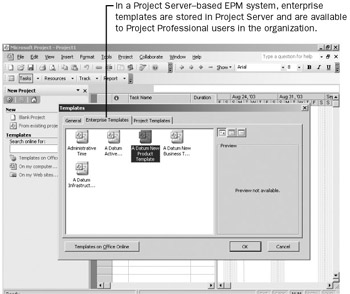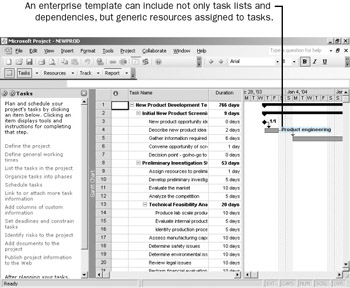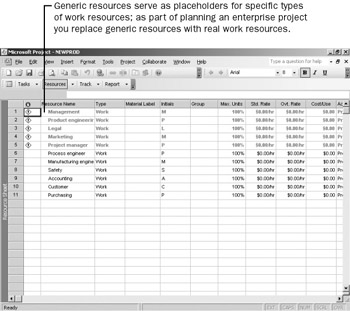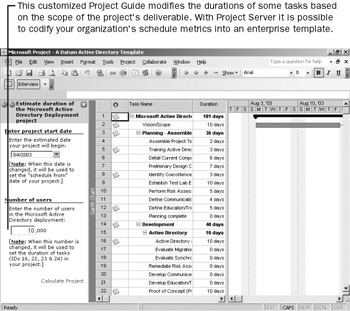Building a New Plan from an Enterprise Template
One of the principal goals of practicing enterprise project management is to have standard ways of describing work in projects across the organization. Previously in this book you’ve been introduced to templates for Project on the desktop. Templates are an excellent way to help ensure consistent project structures and schedule logic, task names, and even initial resource assignments. Such consistency is essential for multi-project or portfolio management within an organization.
In a Project Server–based EPM setting, an organization can implement enterprise templates that reside in Project Server and are available to Project Professional users. Enterprise templates can help enforce organizational standards and give project managers a quicker start when developing new project plans. In this section, you’ll see two of the enterprise templates that are part of the A. Datum Corporation sample database included with Project Server. These enterprise templates will introduce you to generic resources and a customized Project Guide.
As noted above, we don’t require you to have access to Project Server. Instead, we will guide you through some common Project Server–based EPM scenarios. We’ll do this by playing the roles of various Project Server–based EPM users in the A. Datum sample database.
-
Eva Corets, a project manager at A. Datum Corporation, starts Project Professional.
-
On the File menu Eva clicks New, and then selects options in the New Project task pane to view the enterprise templates for Project Professional.

Like all enterprise templates, these are stored in Project Server and are available to Project Professional users at A. Datum Corporation. The people who set up Project Server–based EPM at A. Datum Corporation created the enterprise templates for the most common types of projects the organization does and populated each enterprise template with task lists, schedule logic, and other information that reflects the best practices of the organization.
-
Eva creates a new project plan based on the A. Datum New Product Template.

This project plan has a task list and links between tasks, and generic resources assigned to tasks.
-
Eva switches to the Resource Sheet view, and sees that this project plan already includes several generic resources.

Like regular work resources in a resource pool, generic resources reside in the enterprise resource pool that all Project Server–based EPM users share. Generic resources, as the name suggests, are placeholder resources usually identified by a specific role or job title, such as Manufacturing engineer or Safety. Just like a regular enterprise resource, a generic resource can include cost and skills details. One way to think of a generic resource is as a resource starting point; a certain type of task should be performed by a certain type of resource. The generic resource describes that type of resource but doesn’t represent a specific person or group of people. As a project manager develops a project plan, he or she can initially work with generic resources to make sure the right kinds of roles are assigned to the right tasks and then replace the generic resources with real resources before the tracking stage of the project begins. This replacement can be manual or automated, and is shown later in this chapter.
Elsewhere at A. Datum Corporation another project manager, Steve Masters, is also developing a new project plan.
-
Steve starts Project Professional and opens a different enterprise template, the A. Datum Active Directory Template.

Like the enterprise project template that Eva is working with, this template also includes generic resources assigned to tasks. It also includes a customized Project Guide, which interviews Steve for a few key pieces of information that then affect the project plan.
-
Steve completes the customized Project Guide for this template and enters some essential date and project scope information.

With the information that Steve has provided in the customized Project Guide, Project Professional recalculates the durations of several tasks, as well as sets the correct project start date.
The customization of the Project Guide in the A. Datum Active Directory enterprise template is modest in scope. However, it demonstrates two important things: First, this customized Project Guide shows you that you can, with some development effort, put whatever kind of information you care to into the Project Guide. In mature project management organizations, for example, it is common to find a rigorous and standardized project management methodology that defines how the organization does project management. Such a methodology could be described within a custom Project Guide that is integrated with enterprise templates. Second, this customized Project Guide supplies data, such as the project start date, to the active project plan. More interestingly, it acts on user-entered data, such as a scope estimate (the expected number of Active Directory users, in this case), to modify other values, such as the durations of several tasks. A robust customized Project Guide can serve as the first point of contact and guidance for Project Server–based EPM users in an organization, providing them assistance just when they need it most—as they are building new project plans.
| Tip | To learn more about developing customized Project Guides, connect to MSDN (www.msdn.microsoft.com) and enter the search query Microsoft Project Guide Architecture and Extensibility. |
EAN: 2147483647
Pages: 199